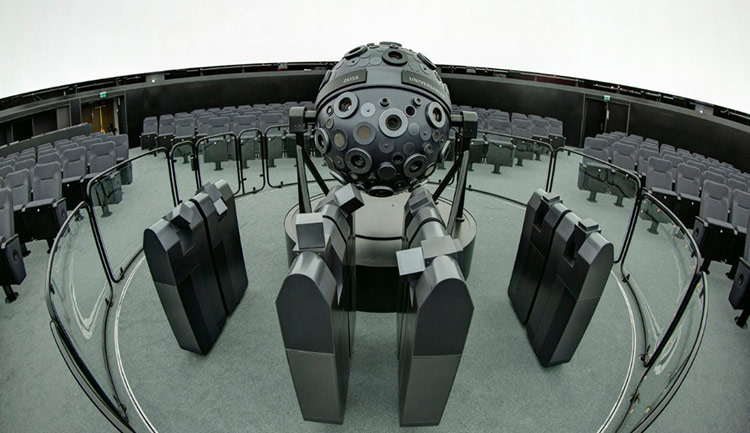ZEISS planetarium in Berlin’s Prenzlauer Berg district will reopen following extensive renovation work and upgrades in the form of new ZEISS technology. The centerpiece of the refurbishment is a ZEISS hybrid planetarium, comprising a video projection system complete with ten ZEISS VELVET projectors for full-dome projection and a star projector of the type ZEISS UNIVERSARIUM Model IX specially built for the Berlin planetarium. This system enables planetarium shows like never before. “With its new ZEISS technology, the planetarium is one of the world’s state-of-the-art star theaters,” says Dr. Martin Wiechmann, Head of the Planetariums business unit at ZEISS.
The ZEISS VELVET projection system enables extremely high-resolution films, videos and visualizations piloted live – such as the space flight through the universe – to be projected onto the 23-meter dome surface in a realistic way. The ZEISS VELVET projection system generates images with more than 25 million pixels – eleven times as many as a movie theater projector. “The ZEISS technology allows us to rethink the planetarium. The technical possibilities open the door to the authentic and breathtaking presentation of all sciences. It the first major step to a science theater that redefines our place in the cosmos in the here and now beyond the limits of astronomy,” says Tim Florian Horn, Head of the large ZEISS planetarium.
While the star projector makes the night sky shine with natural brilliance, the digital projection system supplements the programs with a wide diversity of didactic presentations and colorful astronomical objects taken from current research. Although there are two different projection systems – one mechanical and analog, the other digital – the control software from ZEISS ensures that the two projectors are always in sync. For example, the digital portrait of the Orion Nebula always appears at the right location under the stars.
The ten ZEISS VELVET projectors are spread around the edge of the dome, with each projector generating a partial image. Using automated calibration from ZEISS, all of the partial images are merged so exactly on the dome that visitors see the entire image on the over 700 m2 dome surface. The ZEISS VELVET projectors guarantee the world’s highest contrast. While other projectors always generate a gray haze on the dome, ZEISS VELVET projectors deliver absolute black and therefore exceptionally brilliant colors. “With the ZEISS VELVET system we achieve pitch black, which means that the brilliance of the starlit sky is always reproduced in a hybrid planetarium. The ZEISS VELVET lenses generate such tiny and perfect pixels that visitors can enjoy extremely sharply defined dome images.
This interplay of star projector and digital projection will allow future visitors to the large ZEISS planetarium to leave the earth and embark on a virtual journey through the solar system, discovering space as they do. 3D software based on astronomical databases visualizes the entire observable universe. A flight on the orbit of the Cassini spacecraft shows an outsize Saturn with its characteristic rings passing by on the dome. When flying into intergalactic space, our home galaxy with 200 billion stars, the Milky Way, shrinks to a mere dot of light among billions of other stars. The dome-filling cosmic background radiation testifies to the evolution of the universe.
The large ZEISS planetarium with its impressive 30-meter external dome was opened in 1987 as one of the largest and state-of-the-art star theaters in all of Europe. It is located in Berlin’s Prenzlauer Berg district and, since July 2016, has been part of the newly formed Stiftung Planetarium Berlin (Berlin planetarium foundation) alongside the Archenhold Observatory and the Wilhelm Foerster Observatory and Planetarium on the city’s Insulaner hill. “With this merger, Berlin is making further efforts to become the no. 1 place for astronomical popular science in Germany. The star theaters are being transformed into modern theaters that present science in a comprehensible way,” says Sandra Scheeres, Senator for Education, Youth and Science for Berlin. Renovation and modernization work on the planetarium began in April 2014. Serving as an important testimony to the history of planetariums, the original ZEISS COSMORAMA star projector is being accorded pride of place in the foyer as part of the new exhibition.


